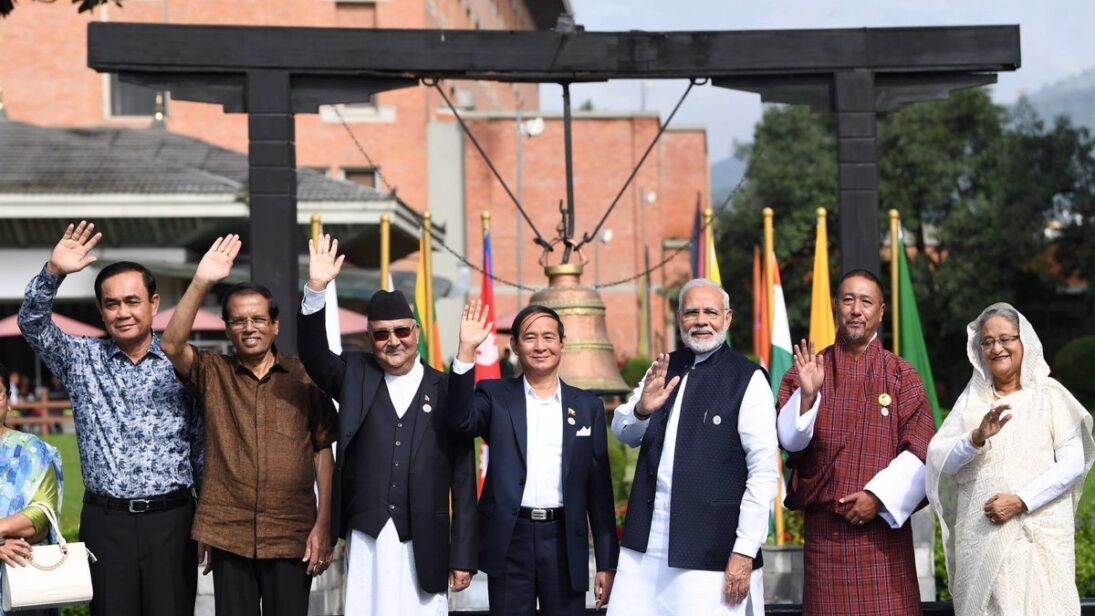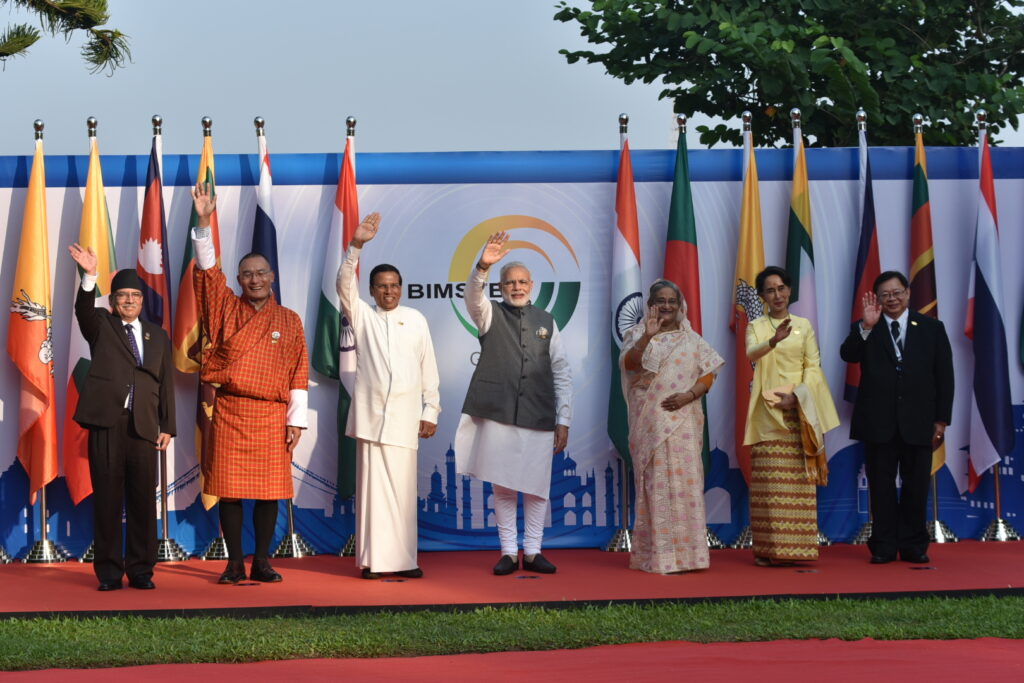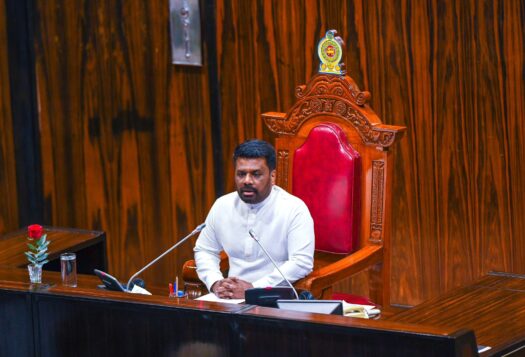
Editor’s Note: This piece originally appeared on 9DASHLINE and has been republished with permission from the editors.
With the sixth BIMSTEC summit scheduled to take place in Thailand in 2024, international media has turned its attention to the grouping to discuss its future prospects. BIMSTEC is a regional organization comprised of member countries from both South and South East Asia. The grouping aims to increase connectivity both within and between these two regions. Although BIMSTEC countries account for nearly 22 per cent of the world’s population, they are located in one of the least integrated regions in the world. Through the proposal of increased regional cooperation, BIMSTEC intends to bring greater peace and prosperity to the Bay of Bengal region. Over the last year, BIMSTEC member states also appear to have renewed their commitment to the initiative. Various conferences and group meetings have taken place over the last few months, including a consultation convened by the Indian External Affairs Minister last week to discuss deepening India’s role in BIMSTEC, which together reflect the member nations’ aspiration to elevate the group’s efficacy and productivity.
The Thailand summit is of particular significance as it will be the first summit to take place just a year after the last. The five previous BIMSTEC summits have taken place four years apart on average, making this year’s summit an indication of member nations’ aspiration to elevate the group’s efficacy and productivity.
Until recently, the South Asian Association for Regional Cooperation (SAARC) has been the primary multilateral body in the region. The increasingly strained relations between member countries India and Pakistan, however, have had a detrimental impact on the group’s productivity. Summit Meetings have completely stopped since the Uri terror attack and the Taliban’s return to power in Afghanistan. SAARC has since been described as “in a state of coma: neither dead nor fully alive”. This current impasse necessitates the emergence of a new grouping to resume and bolster multilateral cooperation in the region.
In the Bay of Bengal region, BIMSTEC can be considered an alternative to the BRI, as it also aims to build local infrastructure and support economic growth but has the sustainable development of its member countries as a fundamental priority.
Although BIMSTEC is a grouping with great promise that has the potential to rise to this challenge, it has had very little visibility over the last two decades. When the organization was first established, they planned to hold summits every two years but in the first 20 years, only three summits were held. When BIMSTEC was established it was decided that its senior officials would meet twice a year, but these meetings were suspended seven times between 2014 and 2017. As a result, it has been difficult for the group to get projects off the ground. Member nations signed a Free Trade Agreement back in 2004 but it is still yet to be fully implemented. The agreement has the potential to revolutionize trade in the region, one economic analysis report concluded it is likely to “generate significant welfare gains for its members”. While member nations have a number of similarly dynamic initiatives in the pipeline, BIMSTEC will require increased funding and the reform of its internal infrastructure to ensure these initiatives materialize.
Potential alternative to the BRI
China’s Belt and Road Initiative (BRI) has been one of the leading projects to expand global connectivity in recent years. However, links are increasingly being made between BRI borrowing arrangements and subsequent economic problems faced by member countries. The BRI held its third forum last month and saw a significant downturn in the attendance of national leaders, dropping from 37 attending the 2019 forum to only 24 this year. BIMSTEC and BRI member Sri Lanka has experienced its worst economic crisis since the country’s independence, exacerbated by unmanageable debt repayments to China and the temporary loss of its Hambantota Port as a consequence of defaulting on these repayments. As the long-term repercussions of BRI engagement continue to be illuminated, it becomes increasingly important to find viable alternatives and BIMSTEC could present this opportunity. Although BIMSTEC and the BRI are by nature different ventures, the former a regional grouping and the latter a project with a global scope, in the Bay of Bengal region BIMSTEC can be considered an alternative to the BRI as it also aims to build local infrastructure and support economic growth, but has the sustainable development of its member countries as a fundamental priority.
A key aspect of BIMSTEC that sets it apart from the BRI is that its relationships are based on interlinkages and interdependence. These aspects work in combination with the group’s underpinning principle of the equality of all members, meaning no single member is granted any greater role or power in the relationship. Interdependence is founded upon mutual trust and is key to keeping all members accountable. The BRI tends to create an over-dependence on the benefactor, who holds the power in the relationship and has no equal to ensure accountability.
It is also notable that in BIMSTEC’s charter, one of the first priorities outlined is the bloc’s commitment to its landlocked member countries — Bhutan and Nepal. The charter states the importance of “recognizing the special needs and circumstances of the least developed and landlocked developing countries in the region and underlining the necessity to provide meaningful support to their development process”. The landlocked countries in the grouping have the greatest dependency on fellow members, who can provide them with access to vital trade routes that then connect these countries to regional and global markets.

The fact that the most dependent countries in the grouping are given such priority in the charter indicates the group’s commitment to ensuring equitable development and that the members with the greatest needs receive the necessary support to achieve greater economic stability. BIMSTEC has already identified boosting its intra-regional trade as one of the best ways to support the economies of these landlocked countries and has since been working on Motor Vehicle Agreements to better facilitate passenger and motor travel between member countries. Nepal’s Ministry of Foreign Affairs reported that BIMSTEC was working on the ‘early conclusion’ of such agreements, which indicates that the grouping is also prioritizing these countries in practice.
Determination to progress
Alongside these solid foundations, the grouping has also shown commitment to reform in recent months. This year they published a series of documents, including the ‘Rules of Procedure for Core BIMSTEC Mechanisms’, which aimed at tackling efficiency problems with their current organizational structure. As most relations in the region have historically been bilateral, these inner mechanisms are crucial in aiding the transition to effective multilateral dialogue. BIMSTEC has also discussed implementing a dispute-resolution mechanism to prevent inter-member or national conflicts from hindering their operational capacities, as it has done with SAARC.
A BIMSTEC delegation has recently met with the ASEAN Secretariat in Indonesia to learn about the organization’s mechanisms and see how their best practices can be integrated into BIMSTEC’s own infrastructure. As BIMSTEC includes members from South East Asia, the meetings were also intended to explore the possibility of the two groupings working together in future to reinforce collaboration between South and South East Asia. The desire to work with and learn from other multilateral bodies is another promising aspect of BIMSTEC’s development strategy.
Learning from the BRI’s mistakes
It will be important for BIMSTEC to learn from the mistakes of the BRI if it is to work as a viable alternative for countries in the Bay of Bengal region. One key aspect that will be crucial for the grouping to focus on is the environmental sustainability of its projects. A study carried out by the Collective on Chinese Financing and Investments, Human Rights and the Environment analyzed 26 different BRI projects across Argentina, Bolivia, Brazil, Chile, Colombia, Ecuador, Mexico, Peru, and Venezuela. They found that BRI-funded infrastructure had contributed to both deforestation and water pollution. Pollutants found included cyanide, metabisulfite, and peroxide and the study also detected disruption to local watersheds that led to flooding, or droughts in other cases. It appears that administrators of certain BRI projects have not conducted or implemented the necessary risk assessments to ensure the safety of their infrastructure and that the affected member countries have paid the price for this failure. BIMSTEC is already working with climate change strategy specialists to help develop their policies and it will be essential for the grouping to continue and further this engagement with experts to ensure each of their initiatives are designed with the preservation of the environment as a primary focus.
BIMSTEC has also discussed implementing a dispute-resolution mechanism to prevent inter-member or national conflicts from hindering their operational capacities, as it has done with SAARC.
It will also be important for BIMSTEC initiatives to be devised and implemented with a policy of transparency. The BRI has been criticized for its lack of transparency with loans to BRI members, notably in the cases of Sri Lanka and Zambia where this confidentiality hindered both countries’ ability to effectively restructure their debt repayments. This transparency will also be essential to encourage the involvement of other international institutions with BIMSTEC’s projects, as these institutions tend to require a level of openness before they decide to become involved.
In order for BIMSTEC to develop and adopt these progressive strategies, however, it is crucial the grouping receives both guidance and funding from key actors already established in the region. The Quad, a minilateral forum invested in the Indo-Pacific, could present this opportunity. The grouping has recently been looking to expand its role from a security focus to working on more economic development projects. As increased economic stability directly correlates with enhanced national security, investment in these projects will also further serve the Quad’s security goals. Members of the Quad have already shown motivation to pursue economic development initiatives similar to those of BIMSTEC, by investing in projects such as the Blue Dot Network, which aims at ‘improving standards of infrastructure investment’ in the Indo-Pacific. Such initiatives also aim to reduce the dependency of countries in the region on China by providing an alternative to the BRI. BIMSTEC and the Quad therefore seem well-positioned to embark upon future collaboration.
It is clear that BIMSTEC has great potential for enhancing the connectivity and prosperity of the Bay of Bengal region. Its principle of interdependence and demonstrated commitment to its most economically vulnerable member countries suggests sincere dedication to the equitable development the region requires. As certain nations in the region have started to withdraw from BRI agreements, including Bangladesh’s decision to scrap their Sonadia deep-sea port project, they are actively seeking alternative avenues for investment. Now is the perfect time for BIMSTEC to rise to the challenge.
Also Read: Revival of Bay of Bengal: Bhutan and Bangladesh Agree on Sea Port Access.
***
Image 1: BIMSTEC Retreat in 2018 via Flickr.
Image 2: BIMSTEC Leaders in 2016 via Flickr.


